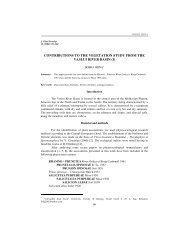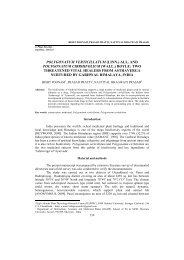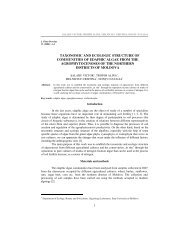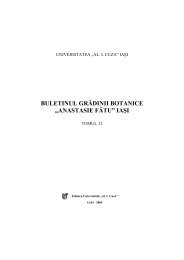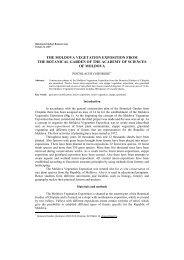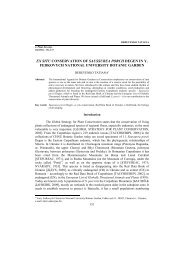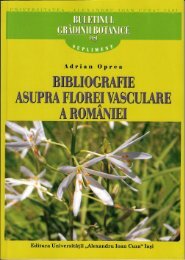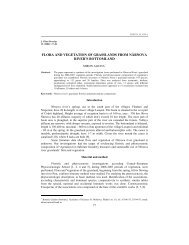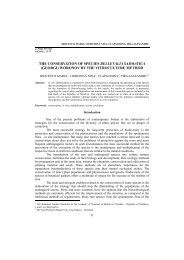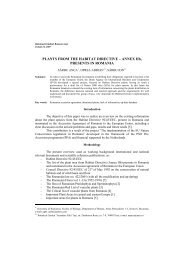importance of mushroom colections used for mycology knowledge
importance of mushroom colections used for mycology knowledge
importance of mushroom colections used for mycology knowledge
You also want an ePaper? Increase the reach of your titles
YUMPU automatically turns print PDFs into web optimized ePapers that Google loves.
IMPORTANCE OF FUNGAL COLLECTIONS FOR MYCOLOGY IN THE FRAME OF …<br />
Nr.<br />
Collections<br />
Abbreviation<br />
Organisms etc.<br />
crt. (in alphabetical order)<br />
1 2 3 4<br />
20h. Universidad National de Córdoba,<br />
Argentina (LAM)<br />
LAM<br />
20i. LE(BIN)<br />
Basidiomycete Collection Russia<br />
LE(BIN)<br />
20j. VKM Russia VKM<br />
21. Microbial Strain Data Network:<br />
<strong>mushroom</strong> databases<br />
22. Mycobase (LCP)<br />
Cryptogamy Laboratory (LCP) and<br />
Natural History Museum from Paris<br />
23. Spanish Type Culture Collection /<br />
La Colection Espanola de Cultivos<br />
Tipo (CECT)<br />
24. United Kingdom National Culture<br />
Collection – CABI Bioscience<br />
(anterior IMI) + National Collection<br />
<strong>of</strong> Yeasts (NCYC)<br />
25. University <strong>of</strong> Alberta Micr<strong>of</strong>ungus<br />
Collection and Herbarium - Canada<br />
26. Uppsala University Culture<br />
Collection Sweden<br />
27. World Data Centre <strong>for</strong><br />
Microorganisms<br />
MSDN<br />
LCP<br />
CECT<br />
UKNCC<br />
NCYC<br />
UAMH<br />
UPSC<br />
WDCM<br />
Public and commercial resources<br />
<strong>for</strong> mycologists<br />
4000 isolated fungi<br />
Fungi<br />
Bacteria<br />
Over 9500 isolated ascomycetes,<br />
hyphomycetes, fungi which<br />
producing human and animal<br />
diseases, micorrhyzant fungi<br />
Over 3000 isolated fungi<br />
Over 400 collections registered<br />
from more than 50 countries<br />
The techniques <strong>used</strong> inside to living cultures <strong>of</strong> microorganism’s deposits,<br />
including fungi, are correlated with a Brevet Request, become a common fact around the<br />
world [STOICA, VASSU & SĂSĂRMAN, 2002].<br />
For the guarantee <strong>of</strong> a complete recognition <strong>of</strong> an invention concerning<br />
microorganisms (including fungi) it was initiated Treaty from Budapest (1977). It was<br />
signed by World Intellectual Property – WIPO and it starting to act since 1980. This<br />
international organization included the culture collections into International Depositary<br />
Authority (IDA) as (micro) biological material depositor <strong>used</strong> <strong>for</strong> strain patents. The states<br />
which have signed the Treaty from Budapest decided that the basic principle <strong>used</strong> <strong>for</strong><br />
obtained patents is to deposit the microorganisms into a single deposit IDA [STOICA,<br />
VASSU & SĂSĂRMAN, 2002].<br />
A culture collection could become an IDA if it receives this noun from state which<br />
comes from, but this collection has to accomplish all demands from Treaty from Budapest<br />
Statutes. Until now, only 30 microbial collections obtained IDA Collection Statute. IDA<br />
Collections has to <strong>of</strong>fer facilities <strong>for</strong> analysis, keeping alive and maintaining pure (free<br />
from contaminants) during a period about 30 years minimum [STOICA, VASSU &<br />
SĂSĂRMAN, 2002].<br />
116



